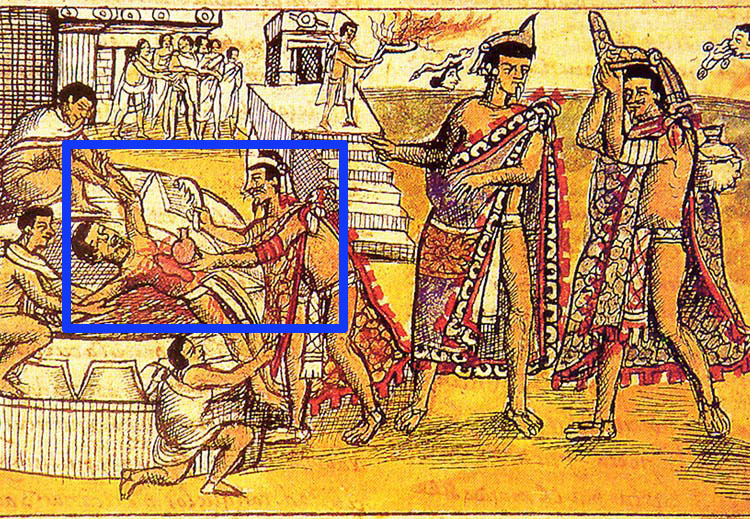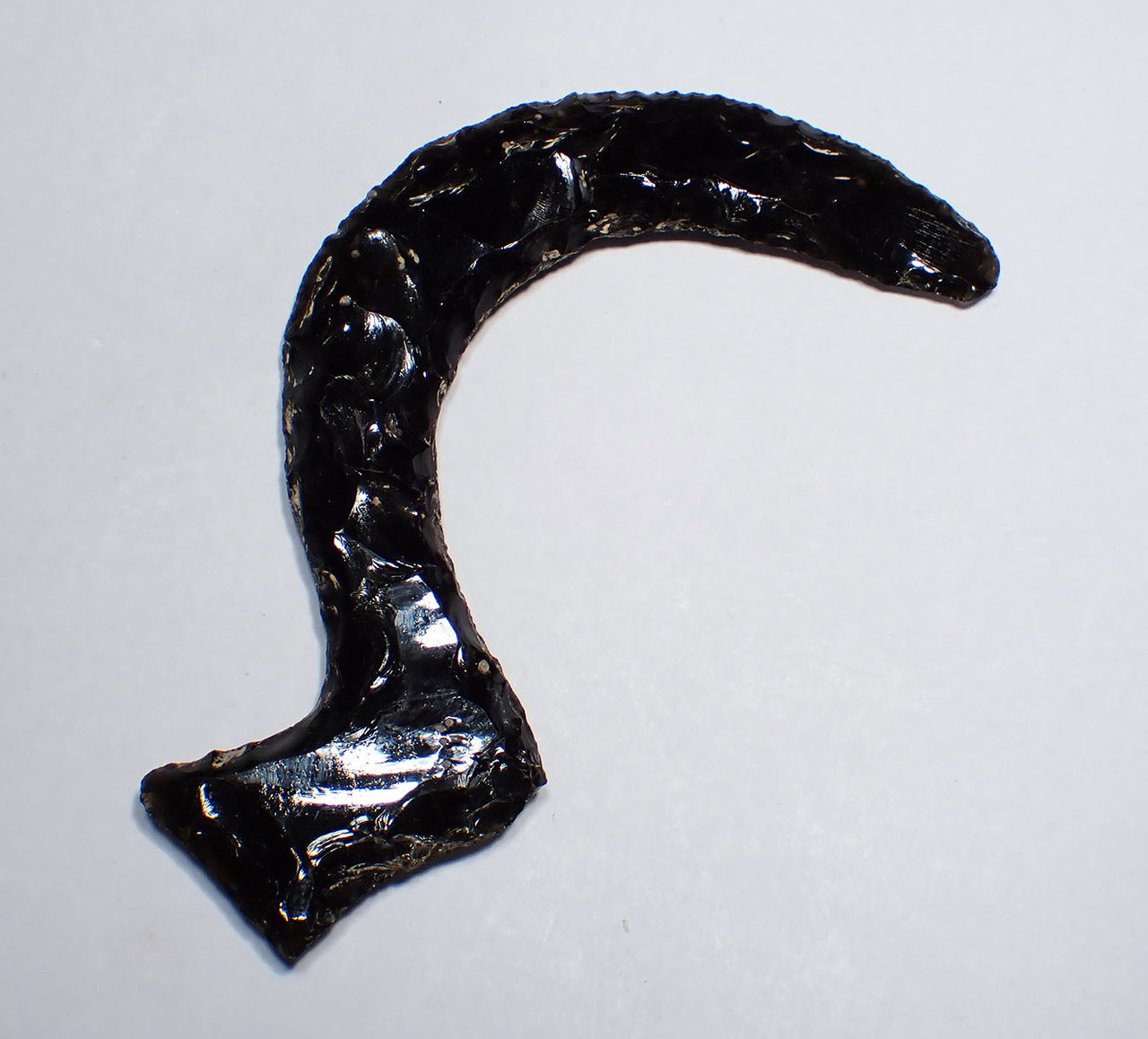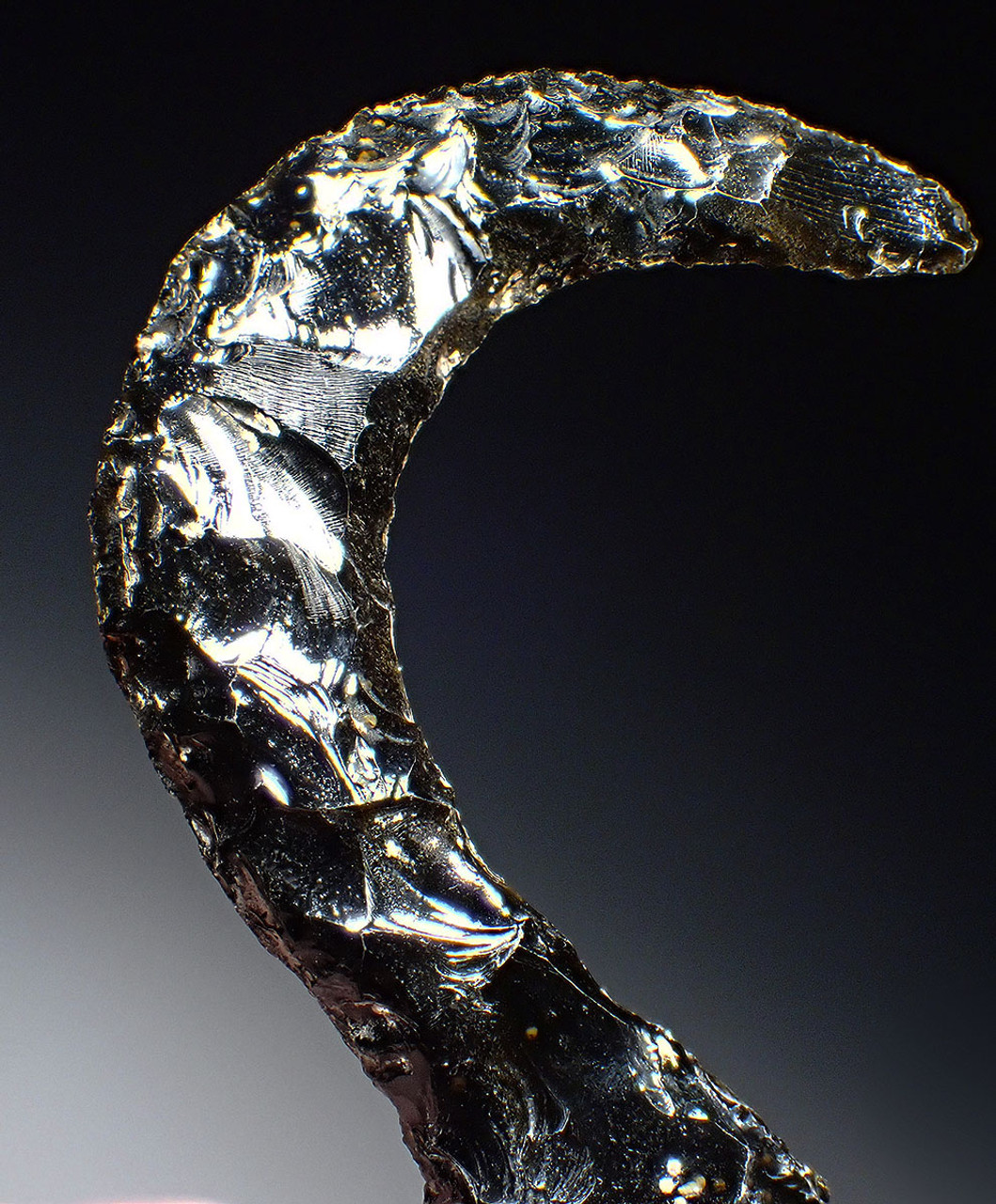Product Description


This is an ULTRA-RARE ritual human sacrifice tool from the Pre-Columbian Aztec Empire. Made of rare green sheen obsidian, this rare ritual surgical tool is called a hook sickle knife. It was used to cut the main arteries and connective tissue surrounding the heart to extract it from the chest of a human sacrificial victim. Images above from two different Spanish codices, show the Aztecs performing this ritual and in both cases, such a tool can be seen in use. Expertly bifacially flaked with a knobbed proximal end to haft onto a handle, it was made in a very rare sparkling green sheen obsidian. When rotated in strong light, the incredible optical effect in the stone makes it look like thousands of stars are trapped inside the obsidian! The video above on our Youtube channel, shows the optical sheen effect reflecting in the light.
The Aztecs highly prized green obsidian and many ceremonial objects were flaked from this coveted material. An article on the Aztecs and their love from Green obsidian, as well as a different version of this heart removal tool (ITEM B IN PHOTO), can be seen here.
Despite our handling a large number of extremely rare Pre-Columbian stone objects in our 35 year career, this is THE FIRST TIME we have encountered a physical example of this rare type of ceremonial heart removal surgical tool. The most common known type of tool used to remove a heart in human sacrifice ceremonies was a large bifacial leaf blade set into a handle. There are several different way that the process of ritual heart extraction was performed, from cutting the rib cage or sternum, to entering below the sternum and going upward inside the thoracic cavity. That latter method would have required a special knife to be able to reach around within the confines of the rib cage, and cut all that was necessary, in order to free the heart. This hook sickle knife would have been ideally suited for such a task. Even today, sickle knives are used in modern surgery, albeit smaller examples for less dramatic purposes!
This rare sacrificial ceremonial tool is complete, unbroken and without any damage. When held to the light, it shows transparency as well as the tiny bubbles that are responsible for its rare sheen characteristics. Microscopic ancient deposits of mineral and sediment can be seen deep in flake scars - irrefutable indicators ONLY found in AUTHENTIC specimens such as this. From the Dr. Medina Pre-Columbian collection dating to the 1950's, of which a copy of the notarized acquisition letter and documentation will be provided to the buyer.
HISTORY
While many ancient civilizations remain a mystery, little can be left to conjecture when it comes to the details of the Aztec way of life. An extensive and detailed collection of written and pictorial records exist for us today called CODICES (CODEX if singular) were produced before Spanish contact by the native tribes themselves, and afterwards during the Colonial period. These codices were created by the Aztecs in pictorial form, as well as by other indigenous tribal sources, all of which had no written language. Colonial era codices exist in greater number with roughly 500 separate codices known, showing extensive pictograms as well as being written in Spanish, Latin and in the original Nahuatl language.
The origin of the Aztec (Azteca) Empire is legendary. Aztec codices record that they began their wandering journey in 1100 A.D. emerging from their former homeland called Aztlan or "place of the herons", an island in a lake where men went out to fish from boats. The exact location of this region is not known but other than it was northwest of present-day Mexico City, the former center of the Aztec empire, but how far, it is a mystery.
The Aztecas believed they were guided by a blood-thirsty deity they called Huitzilopochtli who communicated to them through four priest-chieftains called teomama. Their god called upon them for his insatiable thirst for human blood and sacrifice. As they migrated south, every indigenous Indian tribe they encountered along the way abhorred the Azteca, as they were known, as they were reviled and scorned for their violent and barbaric ways. During their migration, Huitzilopochtli gave a message to his people that their new identity would no longer be known as Azteca but as Mexica. In around 1325 A.D., as they were fleeing an altercation with the Culhuacans, they were driven to a marsh. Their god Huitzilopochtli consoled them that evening and said he would end their wandering and told them to look for a sign that he will give them that will signify their new homeland which will be "the place of the cactus and the eagle I now name Tenochtitlan". They next day they witnessed an eagle resting on a prickly pear cactus which they interpreted to be the sign they were hoping for.
This marsh, Lake Texcoco, would later become a vast canal-laced highly advanced, super city of stone pyramids and temples known as Tenochtitlan. With a population that grew to an estimated 200,000 people (three times the largest city of Spain at the time!) this became the center of the most powerful and militaristic empire of Mesoamerica - home of the Aztecs. Today, we classify their reign as occupying the Late Post Classic Period from 1250 - 1521 A.D.
The success and rise of the Aztec empire was largely attributed to their dominance through intimidation of their surrounding neighbors from whom they extracted resources from. The effect of their extreme militarism and brutality on their enemies brought a large region of peoples into submission. The highly advanced and complex Aztec social structure, as well as legal system, kept their growth intact and the society orderly. They formed an alliance with the Texcoco and Tlacopan tribes and in 1428 A.D., they defeated the Tepaneca. This triple alliance established a great empire that was predominantly ruled from Tenochtitlan. At its peak, this empire included a large, diverse group of people and spanned an area from the entire Central Mexico region south, into northern Guatemala.
References:
- Fiedel, Stuart J., Prehistory of the Americas, 1992 - Freeman and Company, Early Man in America, 1973
- Hirth Kenneth, Obsidian Craft Production in Ancient Central Mexico, 2006
- Muser, Curt, Facts and Artifacts of Ancient Middle America, 1978
- Phillips, Charles, The Complete Illustrated History of the Aztec and Maya, 2008
- Pohl, John M.D., Aztec, Mixtec and Zapotec Armies. Oxford: 1991
- Schmal, John P., The History of the Indigenous Sinaloa. 2004 - Stuart, Gene, The Mighty Axtecs, 1981
 US DOLLAR
US DOLLAR
 EURO
EURO
 AUSTRALIAN DOLLAR
AUSTRALIAN DOLLAR
 CANADIAN DOLLAR
CANADIAN DOLLAR
 POUND STERLING
POUND STERLING





























